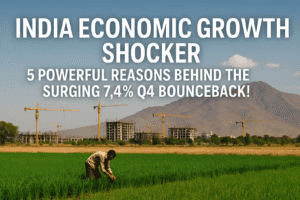India Economic Growth Shocker: 5 Powerful Reasons Behind the Surging 7.4% Q4 Bounceback!
India’s FY25 growth slowed to 6.5%, a four-year low, primarily due to challenging global conditions (trade tensions, Ukraine war) and subdued private investment following the previous year’s strong 9.2% rebound. However, the economy demonstrated significant resilience, culminating in a robust 7.4% Q4 surge – the fastest pace in a year. This late acceleration was driven by revived rural demand, strong government infrastructure spending, a healthy construction sector (10.8% Q4), and a notable agricultural recovery (5.4% Q4).
While manufacturing weakened (4.5% FY25), India retains its status as the world’s fastest-growing major economy. Looking ahead, controlled inflation (3.16% April), potential RBI rate cuts, and a favorable monsoon forecast offer optimism for sustaining growth near the projected 6.5% for FY26, though navigating persistent global uncertainties remains crucial.

India Economic Growth Shocker: 5 Powerful Reasons Behind the Surging 7.4% Q4 Bounceback!
India’s latest economic report card presents a fascinating puzzle: full-year growth slowing to a four-year low while the final quarter surged to a one-year high. This apparent contradiction, far from simple good or bad news, reveals a dynamic economy navigating complex currents. Let’s unpack the real story behind the 6.5% FY25 and the 7.4% Q4 figures.
The Annual Slowdown: Context is Crucial
Yes, the 6.5% growth for the full year 2024-25 (FY25) is India’s slowest since the pandemic-affected years. However, perspective is vital:
- The High Base Effect: This slowdown follows an exceptionally strong rebound year (FY24 at 9.2%), making sustained ultra-high growth challenging.
- Global Headwinds: The year was dominated by significant disruptions – escalating trade tensions (driven by policies like renewed US tariffs) and the prolonged Russia-Ukraine conflict impacting supply chains and energy markets globally.
- Private Investment Caution: Amidst global uncertainty, private capital expenditure remained subdued, acting as a drag on overall momentum.
The Q4 Surge: Signs of Resilience and Tailwinds
The robust 7.4% growth in January-March 2025 (Q4 FY25) wasn’t accidental. Key engines fired up:
- Rural Revival: After a period of strain, rural demand showed tangible improvement. Moderating food prices and a stronger festival season compared to the previous year boosted private consumption (up 7.2% YoY).
- Industrial & Construction Momentum: Robust industrial activity, particularly in construction (growing at 10.8% YoY in Q4), provided a significant lift. This reflects government infrastructure spending and underlying demand.
- Agricultural Bounce: A much-needed acceleration in agriculture (5.4% YoY in Q4, up from a meagre 0.9% a year ago) contributed positively, aided by favourable base effects and potentially improved conditions.
- Government Spending: Continued fiscal support helped counterbalance weaker private investment and navigate global trade disruptions.
The Diverging Paths: GDP vs. GVA & Sectoral Shifts
The data reveals nuanced realities:
- GDP vs. GVA: While GDP grew at 7.4% in Q4, Gross Value Added (GVA) – which strips out taxes and subsidies for a clearer view of core production – was estimated at a more modest 6.4-6.7%. This suggests some of the GDP strength might stem from reduced subsidies rather than purely underlying production growth.
- Sectoral Winners & Losers:
- Construction: Remained a powerhouse (9.4% FY25, 10.8% Q4).
- Agriculture: Showed significant recovery (4.6% FY25 vs 2.7% FY24).
- Manufacturing: Clearly struggled (4.5% FY25, down sharply from 12.3% FY24), reflecting global trade pressures and potentially domestic demand shifts.
Navigating the Path Ahead: Optimism with Caveats
Despite the FY25 slowdown, India retains its crown as the world’s fastest-growing major economy. Key officials and institutions like the IMF (projecting India to surpass Japan’s economy size in 2025) remain bullish. Reasons for cautious optimism include:
- Monetary Tailwinds: The RBI’s first rate cut in five years (February 2025) and the potential for more cuts (given low April 2025 inflation of 3.16% and a favourable monsoon forecast) should boost investment and consumption.
- Inflation Control: Moderating inflation, particularly if food prices stabilize, increases household purchasing power.
- Service Sector Strength & PLI Potential: India’s robust service exports and the gradual impact of Production Linked Incentive (PLI) schemes offer buffers against global goods trade volatility.
- Resilient Domestic Fundamentals: Strong banking health and improving rural demand provide underlying support.
Challenges on the Horizon:
- Global Uncertainty: Ongoing geopolitical tensions and trade fragmentation remain significant external risks.
- Manufacturing Revival: Boosting manufacturing growth is crucial for job creation and broader economic strength.
- Sustaining Investment: Encouraging a sustained pick-up in private investment is key for long-term growth potential.
- Inflation Watch: While currently low, volatility in global commodity prices or monsoon vagaries could reignite inflationary pressures.
The Bottom Line: An Economy in Transition
India’s FY25 growth story isn’t one of simple decline, but of adaptation and resilience. The economy successfully weathered severe global storms, culminating in a strong quarter demonstrating its inherent capacity to bounce back. While the manufacturing slowdown and external risks are real concerns, the foundations – controlled inflation, potential monetary easing, a recovering rural sector, and government focus on infrastructure – suggest India is positioned to navigate towards steadier growth in the 6.5%+ range projected for FY26. The key will be translating policy support and nascent demand recovery into sustained private investment and broader-based growth across all sectors. The journey continues, marked not just by speed, but by increasing resilience and strategic navigation.
You must be logged in to post a comment.